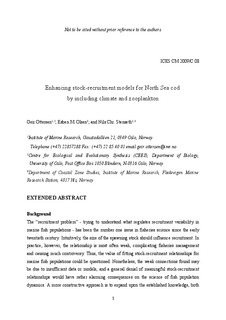| dc.description.abstract | The “recruitment problem” - trying to understand what regulates recruitment variability in
marine fish populations - has been the number one issue in fisheries science since the early
twentieth century. Intuitively, the size of the spawning stock should influence recruitment. In
practice, however, the relationship is most often weak, complicating fisheries management
and causing much controversy. Thus, the value of fitting stock-recruitment relationships for
marine fish populations could be questioned. Nonetheless, the weak connections found may
be due to insufficient data or models, and a general denial of meaningful stock-recruitment
relationships would have rather alarming consequences on the science of fish population
dynamics. A more constructive approach is to expand upon the established knowledge, both
1
by introducing refined models and by including other sources of data. Specifically, theoretical
work suggests that the shape and the position of the stock recruitment curve will be influenced
by the environmental conditions experienced by the fish larvae. Pioneering work by Cushing
and Horwood showed unexpected support for strong density-dependent mortality of fish
larvae, even with low observed larval densities. Their model suggests a positive link between
the number of food organisms and the slope of the stock-recruitment relationship, with
potentially important implications for population dynamics. More recent work suggests that a
Ricker-type stock-recruitment relationship, i.e. overcompensation, could be expected at
limited food levels, while as food availability improves the recruitment curve becomes
monotonically increasing towards an upper limit, i.e. a Beverton-Holt type stock-recruitment
relationship. In both of these modelling approaches, the time to metamorphosis appears
important for recruitment. Lack of food will slow down the growth of the larvae and delay the
time to metamorphosis. This may cause the larval cohort to experience density-dependent
mortality to the extent that the recruitment curve becomes overcompensatory. | no_NO |
